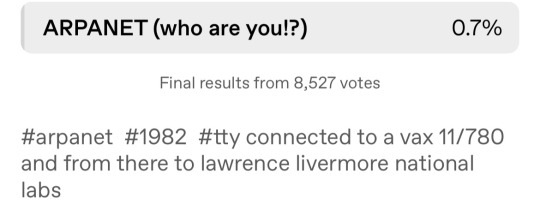#Lawrence Livermore National Laboratory
Photo

(via The Door of Lawrence Livermore National Laboratory In California, USA. : interestingasfuck)
More info:
This photo from 1979 shows a Lawrence Livermore National Laboratory employee opening the world’s heaviest hinged door, which was eight feet thick, nearly twelve feet wide, and weighed 97,000 pounds. A special bearing in the hinge allowed a single person to open or close the concrete-filled door, which was used to shield the Rotating Target Neutron Source-II (RTNS-II) -- the world’s most intense source of continuous fusion neutrons.
#Lawrence Livermore National Laboratory#employee#vintage#world’s heaviest hinged door#used to shield the Rotating Target Neutron Source-II (RTNS-II)#continuous fusion neutrons#danger#will robinson#vintage tech#science
693 notes
·
View notes
Link
By Scott Scheffer
The mission of the Lawrence Livermore Lab is and always has been at the service of the Pentagon. The most significant part of its usable budget is for testing, maintaining, and improving U.S. nuclear missiles. The coverage of the “fusion breakthrough” was the ultimate exercise in greenwashing the continuing menace of the U.S. nuclear weapons stockpile. It was a bait-and-switch con that concealed military research by dressing it up as clean energy research.
#nuclear fusion#Pentagon#imperialism#lawrence livermore national laboratory#greenwashing#nukes#clean energy#Struggle La Lucha
13 notes
·
View notes
Text
Lawrence Livermore National Laboratory achieved a stunning breakthrough on fusion energy
4 notes
·
View notes
Text
I recently saw a post on here that made a really good point about how aniexties about nuclear power often equate nuclear power with nuclear weapons/war. The same people protesting nuclear proliferation back in the day, if they weren't properly informed (which could very easily happen), also protested the opening of nuclear power planets.
But this equation, while ultimately wrong, does have its basis in reality. The lab that did the recent nuclear fusion breakthrough- Lawrence Livermore National Laboratory was originally founded to devlope nuclear weapons. My grandfather used to work in their computation department and wrote programs to direct ICBMs.
4 notes
·
View notes
Text


Lawrence Livermore National Laboratory, National Ignition Facility: Target Chamber where lasers are shot in attempts to do research and perfect cold fusion. More precisely research on inertial fusion energy in hopes of finding the most efficient means of nuclear fusion ignition.
#lawrence livermore national laboratory#national ignition facility#nuclear energy#nuclear facility#Inertial Fusion Energy#nuclear fusion#nuclear physics#cold fusion
1 note
·
View note
Text
Qubit by qubit: Optimizing silicon for quantum computing - Technology Org
New Post has been published on https://thedigitalinsider.com/qubit-by-qubit-optimizing-silicon-for-quantum-computing-technology-org/
Qubit by qubit: Optimizing silicon for quantum computing - Technology Org
Quantum computers harness quantum mechanics to perform computations and solve problems beyond the capabilities of classical computers. While a regular computer consists of billions of transistors, called bits, quantum computers are based on quantum bits, also known as qubits.
BUILDING BETTER QUBITS: While the basic unit of information in a traditional computer, the bit, may be in one of two states (0 or 1), a quantum computer’s qubit may be in a combination of both states. University of Rochester physicist John Nichol is exploring ways to overcome some shortcomings of otherwise promising silicon spin qubits. Image credit: Mark Garlick / Science Photo Library
In the quest to build powerful quantum computers, one type of qubit has shown exceptional promise: silicon spin qubits. These qubits have long coherence times and are compatible with advanced semiconductor manufacturing techniques. Despite this promise, the material used in silicon spin qubits creates recurring challenges for researchers. These include:
Charge noise, or erratic fluctuations in the electrostatic environment surrounding the qubits, making them unstable
Valley splitting, which creates quantum-dot energy levels that can get too close and cause unwanted complications
Spatial variations in electron g-factor, which can lead to difficulty controlling qubits
To overcome these challenges, the US Air Force Office of Scientific Research (AFOSR) has awarded more than $6.7 million to a multidisciplinary team of experts in materials characterization and modeling, silicon fabrication, and quantum experiments. Led by researchers at the University of Rochester, the team includes collaborators at the University at Buffalo; SUNY Stony Brook; NY Creates; University of California, Los Angeles; and Lawrence Livermore National Laboratory.
“We are taking a materials-first approach to discovering the underlying causes of the challenges with silicon spin qubits,” says John Nichol, an associate professor of physics at Rochester and the primary investigator on the project.
AFOSR funds high-risk basic research that has the potential to profoundly impact the nation’s technological progress, in areas including the development of stable and powerful quantum computers. According to Nichol, the office’s funding of a partnership between academia, a national laboratory, and an innovation hub is key to advancing quantum computing.
“This team has the required expertise to investigate correlations and causation in silicon spin qubits and ultimately accelerate progress through materials development in this platform,” he says.
Source: University of Rochester
You can offer your link to a page which is relevant to the topic of this post.
#air#air force#approach#Building#classical#computation#computer#computers#computing#development#electron#energy#Environment#Fabrication#factor#Fundamental physics news#Funding#Innovation#Lawrence Livermore National Laboratory#LED#Link#Manufacturing#material#materials#mechanics#modeling#noise#One#photo#Physics
0 notes
Text
US Department of Energy Offers $33 Million in Funding for AI and Machine Learning in Fusion Energy and Plasma Sciences Research
US Department of Energy Offers $33 Million in Funding for AI and Machine Learning in Fusion Energy and Plasma Sciences Research
The US Department of Energy (DoE) is offering $33 million in funding for researchers who can apply artificial intelligence (AI) and machine learning (ML) to the analysis and simulation of fusion energy and plasma sciences.
The DoE is seeking proposals for the use of AI/ML on existing public data, with a focus on approaches that could support the development of a fusion pilot plant in the near…

View On WordPress
#AI#AI/ML#data resources#DoE#energy#funding#fusion energy#fusion ignition#fusion pilot plant#large datasets#Lawrence Livermore National Laboratory#machine learning#plasma sciences#research#simulation
0 notes
Link
Operating the whole project still took more energy and it was all very expensive to boot, so there's still a long way to go before we're all roasting our fusion burgers, but the results "exceeded expectations," and "advances in recent years mean the technology is likely to be widely used in 'a few decades' rather than 50 or 60 years as previously expected."
#government and politics#fusion#physics#particle physics#science#Lawrence Livermore National Laboratory#us government#nuclear physics#lasers
0 notes
Text
Yeah, Yeah, Switch-Cloverstardropper and Aarin, Stop Gloating

Congrats, we suppose, to the National Ignition Facility at the Lawrence Livermore National Laboratory (LLNL) in California for being the first to do fusion power that generates more energy than was required to do the reaction ahead of our one here in glorious Blighty.
No, we’re really happy for you that your smelly laboratory got there first. Honest.

And this time, don’t immediately run off and try to make a bomb with it first, okay?
Something useful like a power station first - play nicely with your new toy and don’t be big meanies.
Commiserations to the Arabs and everyone else with oils and lots of fossil fuels, if your economies weren’t already in trouble from climate change reforms, you’re really on your last life before Game Over, Insert Coin now.
#switch#cloverstardropper#aarin#lawrence livermore national laboratory#california#fusion#we are after all talking about a nation where the residents make lethal explosives with cola and artificial mints ...
1 note
·
View note
Quote
They shot a bunch of lasers at a pellet of fuel and more energy was released from that fusion ignition than the energy of the lasers.
Arati Prabhakar - Dec. 13 2022
1 note
·
View note
Text
#Chuck#Modlin#Lawrence#Livermore#National#Laboratory#CIA#Battelle#Memorial#Institute#USAPs#Unacknowledged#Special#Access#Programs#Clifford#Cliff#International#Director#MUFON#silence#group#shadow#government#ARVs#Alien#Reproduction#Vehicles
0 notes
Text

Lawrence Livermore National Laboratory world’s heaviest door
3K notes
·
View notes
Text
The Guardian
Aug. 6, 2023
The Lawrence Livermore National Laboratory’s National Ignition Facility achieved the feat using lasers to fuse two atoms
US scientists have achieved net energy gain in a nuclear fusion reaction for the second time since a historic breakthrough in December last year in the quest to find a near-limitless, safe and clean source of energy
Scientists at the California-based Lawrence Livermore National Laboratory repeated the breakthrough in an experiment in the National Ignition Facility (NIF) on 30 July that produced a higher energy yield than in December, a Lawrence Livermore spokesperson said.
Read more.
2 notes
·
View notes
Note

????
Prior to the early 1990s you couldn't just access the internet because you wanted to. Only people with a connection to the US Defense Department were allowed* to use it. That included a lot of universities under contract with the US Government (not always the DoD.)
* In theory. In practice you just needed a buddy who was a systems administrator for said contractor. That's how I first gained access, in 1982 I was a physics grad student with buddies in the High Energy Physics lab. They had access through the Lawrence Livermore National Laboratory. So they gave me access via a dumb TTY terminal on the physics department's DEC VAX 11/780 minicomputer. It was useful as a way of connecting to other LGBT+ computer nerds on net.motss ("members of the same sex") which may have been the world's first queer social networking system. I'm that much of a relic. (By 1986 I was also developing communications equipment for the early internet, which at that time was called the Defense Data Network. I still have one of the old DDN tech manuals around the house somewhere. One of my gaming buddies was Roy Fielding, coinventor of HTTP and inventor of the RESTful API. I also know everyone quoted in the following article. )
83 notes
·
View notes
Text
For a second time since its landmark fusion event in 2022, the US National Ignition Facility (NIF) has squeezed enough energy out of a diamond capsule packed with hydrogen to keep the fusion reaction running.
Though still far short of producing a reliable, self-sustaining source of power for the community, the repeat achievement is bound to provide vital information on how to improve the technology.
Based at the Lawrence Livermore National Laboratory near San Francisco, the NIF's experimental fusion program uses some of the world's most powerful lasers to force hydrogen atoms into new configurations, leaving spare change in energy.
Continue Reading
87 notes
·
View notes